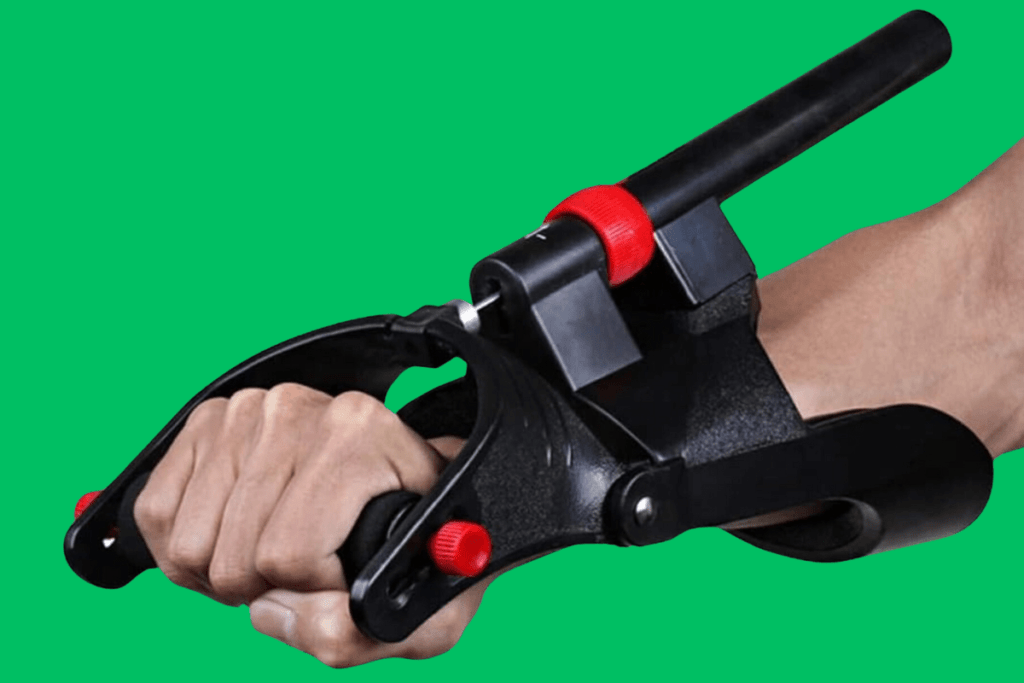If you want to learn how to get bigger arms fast, you need a smart approach with effective training, proper nutrition, and consistency. In this article, we are going to point out the most important exercises, techniques, and lifestyle habits for getting bigger arms. Let’s get started!
Exercise:
Increase weight: As you build strength, opt for heavier dumbbells or add more weight to your barbells.
Increase reps/sets: Gradually increase your repetitions or sets for each exercise.
Decrease rest time: Shorten your rest intervals between sets to keep your muscles under tension for longer periods.
Proper form: Always focus on form over lifting heavier weights. Focus on controlled movements. And get more time for establishing a mind-muscle connection. It will enhance muscle engagement and avoid injuries.
Frequency: Set a goal to work on your arms 2-3 times a week. Ensure enough time for recovery between sessions. Then you will learn faster how to get bigger arms.
Focus on compound exercises:
While your goal is to build larger arms, train your full body to achieve balanced muscle growth. Compound exercises that engage many muscle groups, including your arms. Such as bench presses, rows, pull-ups, and shoulder presses. These exercises not only enhance strength but also promote muscle growth.
For example:
Bench press: Engages the triceps, shoulders, and chest.
Rows: Target the biceps while also working the back muscles.
Pull-ups and chin-ups: It is excellent for developing the back and biceps.
Shoulder Press: Focuses on the triceps and shoulders.
Targeted Arm Brace Exercises:
Bicep Exercises: Focus on engaging the biceps brachii muscle. It is on the front of your upper control arms.
Barbell Curls: Stand with a barbell in hand, palms facing forward, and curl the weight up towards your shoulders.
Dumbbell Curls: Like barbell curls, using dumbbells allows greater motion.
Hammer Curls: Hold dumbbells with a neutral grip (palms facing each other) and curl them up towards your shoulders.
Tricep Exercises: Aim to target the triceps brachii muscle, found on the back of your upper control arms bands.
Close-Grip Bench Press: Perform a bench press with your hands positioned closer together to emphasize the triceps.
Tricep Dips: Use parallel bars or a bench to dip down, focusing on extending your arm bands to engage the triceps.
Tricep Pushdowns: Use a cable machine with a rope attachment to push the weight down, specifically targeting the triceps.
Do rocker arm exercises:

Often overlooked, these are important for forearm strength and aesthetics.
Wrist Curls: Hold a dumbbell in each hand, palms facing up, and curl your wrists upward.
Reverse Curls: Like regular curls but with an overhand grip, which targets the forearm extensors.
Farmer’s Walks: Hold heavy dumbbells or kettlebells at your sides and walk a distance, engaging grip strength and forearms.
Isolation Exercises:
Compound workouts are essential for building strength and muscle mass. It is also important to include isolation exercises for smaller muscles in your arms.
For example:
Bicep: Preacher curls and concentration curls.
Tricep: Tricep kickbacks and skull crushers.
Variety in Rep Ranges: To target different muscle fibers and encourage growth, mix up your workouts. You can add a variety of rep ranges. You can follow these:
Low Reps (1–5): Focus on heavy lifting to optimize strength growth.
Moderate Reps (6–12): These create metabolic stress. It is ideal for hypertrophy (muscle growth).
High Reps (12+): Aim for muscle exhaustion and increased metabolism.
During each repetition, focus on feeling your muscles contract. Keep tension throughout the movement and visualize the muscles working. This helps to ensure you’re concentrating on the muscle and maximizing its growth potential.
Use techniques like supersets and drop sets to ramp up your workouts and induce muscle fatigue. These methods boost the training volume and metabolic stress on your muscles. It performs in many sets consecutively with minimal rest.
To extend the time your muscles are under tension during each set, control the speed of your repetitions. Speeding up the eccentric phase of a movement can increase the risk of injury while promoting muscle growth. Follow a two- to three-second eccentric phase with a controlled concentric (lifting) phase.
Consume a pre-workout meal rich in protein and carbohydrates to improve muscle function and fuel your workouts. After exercising, have a post-workout meal or shake that is high in protein and carbs to aid recovery and replenish glycogen stores.
Staying properly hydrated is essential for muscle growth and repair. Drink plenty of water throughout the day, especially in the hours before, during, and after your workouts. Prioritizing hydration is key, as dehydration can impede muscle growth and performance.
Stress can adversely affect your body’s ability to build muscle. Engage in stress-relief activities such as yoga, deep breathing, and meditation. Or spend time outdoors to promote healing and relaxation.
Listen to your body’s feedback on your exercise routine. If you’re not seeing progress or are feeling sore, it is best time to adjust your training volume. You have to increase intensity or recovery strategies.
Use recovery methods to learn how to get bigger arms. Such as foam rolling, stretching, massage, and contrast baths to reduce muscle tightness. Increase your range of motion and speed up recovery between workouts.
Other Advice on How to Get Bigger Arms:
Rest and Recovery: Give your muscles enough time to recuperate between workouts. Get seven to eight hours of sleep every night.
Warm-up and Cool-down: To prepare your muscles for exercise, always wear arm warmers before and cool down afterward to promote healing. Reasonable Expectations: It takes time and effort to build muscle. If you do not notice results right away, do not give up. With careful form, increasing overload, and a balanced diet, you’ll notice your arms get bigger over time.
Advanced Training Methods:
Drop Sets:

Lower the weight and continue until you exhaust yourself after a set of exercises. Targeting distinct muscle fibers helps optimize muscle growth.
Supersets/Giant Sets: Perform two or more forearm, triceps, or biceps exercises back-to-back with little to no rest between. This makes the exercise more intense and gives the muscles more time to tense up.
Partial reps: These can be utilized to further exhaust a muscle after a set. Concentrate on a particular area of the exercise using a reduced weight.
Advanced Programming:
Push-Pull-Legs Split: This split dedicates one workout each to pushing muscles. For example, the chest, shoulders, triceps pulling muscles (back, biceps), and legs. This allows for focused training on arms twice a week.
Arm Specialization Routine: After your main workout, dedicate a separate session solely for arms. This can be particularly beneficial for those lagging in arms development. Then, ensure proper recovery with this approach.
Building a Strong Foundation:
Focus on compound exercises: Don’t underestimate exercises like rows, pull-ups, and overhead presses. These work many muscle groups, including your arms, and contribute significantly to strength and size.
Develop core and back strength: A strong core stabilizes your body during lifts, allowing you to use heavier weights for arm exercises. Strong back muscles support proper form and prevent injuries.
Optimizing Nutrition:
Post-workout meal: Consume a protein shake or meal rich in protein and carbohydrates within 30 minutes after your workout. It is important to jumpstart muscle recovery and growth.
Track your macros with HIIT Workout: Precisely track your macronutrients (protein, carbs, fats). It will ensure you’re hitting your daily goals and fueling your body for muscle building.
Consider Creatine: Creatine is a well-researched supplement that can enhance muscle growth and strength gains, potentially benefiting your arm development. But consult a doctor before starting any supplements.
Remember:
Individual Needs: These are general guidelines, and individual results may vary. Be patient, adjust your approach based on your progress, and consult a certified trainer or nutritionist for personalized guidance.
Listen to your body: Don’t push yourself to the point of injury. Take rest days when needed, and focus on proper form over lifting heavier weights with compromised technique.
Advanced Methods (use with caution):
Blood Flow Restriction Training: This workout technique uses inflatable cuffs to restrict blood flow to the exercising muscle area. Even though some studies have shown promise, there are risks involved, and the correct technique must be used. See a qualified expert before attempting this.
Advanced Isometric Training: Holding a static muscle contraction is the goal of isometric workouts. Extended holds or mixing isometric holds with dynamic movements are examples of advanced variations. These can be difficult, and to prevent injury, you need a strong foundation.
Advanced Programming Splits (suitable for lifters with experience):
High-frequency training: This type of exercise includes working your arms four to six times a week at a reduced volume per session. For seasoned lifters with superior recuperation skills, this may old workout, but be careful not to overtrain.
Specificity training: This entails focusing on particular arm weaknesses. If your triceps aren’t growing as quickly as they should, divide a section of your training into specific tricep workouts using different rep ranges and approaches.
Extra advice on how to get bigger arms sleeves:
Use Active Recovery: To encourage blood flow and healing, do exercises like yoga or mild cardio.
Make sleep a priority: Try to get 8 to 10 hours of good sleep every night. Sleep is necessary for the growth of the arm and the repair of muscles.
Track Your Progress: Measure your arms sometimes. Note any increases in strength so you can assess how you’re doing and change your program as necessary.
It’s important to identify the significant risks of these advanced techniques. Because programming is not suitable for everyone. Consulting with a strength and conditioning coach or a qualified personal trainer will ensure your proper form. So, follow a suitable program for your skill level and cut the risk of injury. By following these strategies and staying committed to your goals, you can learn easily how to get bigger arms. Remember, the key to success in fitness lies in consistent effort on time. So be patient and stay focused.











44 Comments
buy amoxil without a prescription – combamoxi cheap amoxicillin without prescription
amoxil price – cheap amoxicillin without prescription amoxil uk
order diflucan online cheap – flucoan where can i buy fluconazole
diflucan pill – https://gpdifluca.com/ purchase fluconazole online cheap
purchase cenforce pill – cenforce oral order cenforce without prescription
cenforce sale – cenforce 50mg cost buy generic cenforce 50mg
cialis where can i buy – https://ciltadgn.com/ pregnancy category for tadalafil
cialis high blood pressure – this tadalafil (tadalis-ajanta) reviews
what is cialis prescribed for – https://strongtadafl.com/# tadalafil professional review
overnight cialis – where can i buy cialis over the counter cheapest 10mg cialis
zantac 300mg brand – https://aranitidine.com/# where can i buy zantac
order ranitidine without prescription – aranitidine buy ranitidine online cheap
is it legal to order viagra from canadian – https://strongvpls.com/ viagra 50 mg price walgreens
order viagra online india – https://strongvpls.com/# viagra buy switzerland
With thanks. Loads of expertise! buy furosemide diuretic
Thanks an eye to sharing. It’s first quality. neurontin pastillas
I’ll certainly bring back to review more. https://gnolvade.com/
This is the stripe of content I take advantage of reading. https://buyfastonl.com/
Thanks an eye to sharing. It’s outstrip quality. https://ursxdol.com/doxycycline-antibiotic/
Greetings! Jolly productive suggestion within this article! It’s the scarcely changes which will obtain the largest changes. Thanks a quantity towards sharing! https://ursxdol.com/doxycycline-antibiotic/
Thanks for putting this up. It’s evidently done. https://prohnrg.com/product/atenolol-50-mg-online/
This is the gentle of literature I positively appreciate. https://prohnrg.com/product/loratadine-10-mg-tablets/
Thanks on putting this up. It’s understandably done. qu’est-ce qui peut remplacer le viagra sans ordonnance
This is a topic which is near to my verve… Many thanks! Exactly where can I upon the contact details in the course of questions? https://aranitidine.com/fr/prednisolone-achat-en-ligne/
This website exceedingly has all of the low-down and facts I needed about this subject and didn’t positive who to ask. https://ondactone.com/product/domperidone/
More posts like this would prosper the blogosphere more useful. https://ondactone.com/product/domperidone/
The depth in this tune is exceptional.
https://proisotrepl.com/product/methotrexate/
This is the description of glad I have reading.
https://doxycyclinege.com/pro/sumatriptan/
I couldn’t hold back commenting. Adequately written! http://www.whatsmywebsiteworth.info/value.php?site=https://www.startus.cc/company/stockholm
More articles like this would frame the blogosphere richer. http://www.zgqsz.com/home.php?mod=space&uid=846485
I couldn’t resist commenting. Warmly written! http://www.cs-tygrysek.ugu.pl/member.php?action=profile&uid=98489
buy forxiga online – this order forxiga 10mg generic
forxiga 10mg uk – dapagliflozin 10mg pills dapagliflozin brand
purchase orlistat without prescription – xenical generic xenical canada
buy xenical pills for sale – this orlistat 120mg cheap
More posts like this would create the online elbow-room more useful. http://iawbs.com/home.php?mod=space&uid=916801
I couldn’t turn down commenting. Profoundly written! http://www.kiripo.com/forum/member.php?action=profile&uid=1193122
You can protect yourself and your ancestors close being wary when buying panacea online. Some pharmaceutics websites manipulate legally and sell convenience, solitariness, cost savings and safeguards to purchasing medicines. buy in TerbinaPharmacy https://terbinafines.com/product/januvia.html januvia
You can shelter yourself and your family close being wary when buying prescription online. Some pharmacy websites control legally and provide convenience, privacy, bring in savings and safeguards for purchasing medicines. buy in TerbinaPharmacy https://terbinafines.com/product/premarin.html premarin
Thanks on putting this up. It’s evidently done. gale stromectol
The vividness in this tune is exceptional. TerbinaPharmacy
More content pieces like this would create the web better.
This is the make of delivery I turn up helpful.
Besonders in Deutschland erfreuen sich solche Casinos großer Beliebtheit, da sie Spielern die Freiheit bieten, nach eigenen Vorlieben zu spielen. Online Casinos mit deutscher Lizenz, kann man nur noch mit einem Höchsteinsatz von maximal 1 Euro pro Spielrunde spielen. Bisher wurde hauptsächlich über Einzahlungs- und Einsatzlimits gesprochen, die deutsche Spieler in von Deutschland regulierten Casinos besonders stören. Casinos mit einer deutschen Lizenz bieten in der Regel eine deutlich kleinere Auswahl an Spielen und Entwicklermarken im Vergleich zu ihren international regulierten Konkurrenten. Gerade Spieler, die mit ihren Einsätzen nicht gut umgehen, können schnell viel Geld verlieren, wenn sie ohne Einsatzlimit spielen. Neben der allgemeinen Übersicht über Spiel, die ihr in unseren Casinos ohne Einsatzlimit von einem Euro spielen könnt, wollen wir euch auch gleich Top Spiele nennen.
Alle neuen Spiele von Nolimit City, Push Gaming, Pragmatic Play oder Hacksaw Gaming sollten in einem Online Casino mit einem Einsatz von mehr als 1 Euro spielbar sein. Dort konnte uns der deutsche Kundensupport zu 100 Prozent überzeugen. Damit diese Einzahlungen auch reibungslos klappt, sollte man euch verschiedene Zahlungsmöglichkeiten anbieten. In Deutschland gilt demnach das monatliche Einzahlungslimit von 1.000 Euro, doch geht in den Casinos ohne Limit deutlich mehr. Zugegebenermaßen ist es natürlich von Vorteil, dass so viele Casinos ohne Limits für deutsche Spieler vorhanden sind. Zahlt nun euer erstes Guthaben im Online Casino ohne Limits ein und nutzt zudem bei Bedarf einen attraktiven Willkommensbonus.
References:
https://online-spielhallen.de/lapalingo-casino-aktionscode-ihr-umfassender-leitfaden/